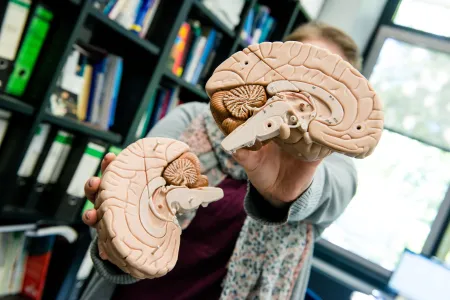
New perspectives
How philosophy can change the understanding of pain
A German-Canadian research team is calling for a more comprehensive approach.
Dr. Sabrina Coninx from Ruhr-Universität Bochum and Dr. Peter Stilwell from McGill University, Canada, have investigated how philosophical approaches can be used to think in new ways about pain and its management. The researchers advocate not merely reducing chronic pain management to searching and treating underlying physical changes but instead adopting an approach that focuses on the person as a whole. Their work was published online in the journal “Synthese” on 15 April 2021.
It is not currently possible to treat chronic pain effectively in many cases. This has encouraged researchers from various disciplines to consider new approaches to pain and its management over recent years. “Pain research and clinical practice do not take place in a vacuum, but instead involve implicit assumptions regarding what pain is and how it can be treated,” says Sabrina Coninx, research assistant at the Bochum research training group Situated Cognition. “Our aim is to shed light on these assumptions and discover how we can think in new ways about pain and its management with the help of philosophical approaches.” In their work, the authors develop a holistic, integrative and action-oriented approach.
Viewing patients as a whole
In specific terms, they suggest three things: firstly, addressing pain should involve more than just looking for and treating underlying physiological changes. A holistic approach places the focus on patients as a whole and creates space for their experiences, concerns, expectations and narratives. The influence of socio-cultural practices in the generation of chronic pain should also be taken into account. For example, pain patients are often initially encouraged to protect themselves from injury and avoid activity, which may be helpful in the beginning but can contribute to chronification in the long run.
Secondly, according to the researchers, chronic pain should be understood as a dynamic process in which many different factors interact in a non-linear way. The initial cause of pain, for instance, is not necessarily the cause of its chronification and also does not need to be the most crucial factor in treatment. The complex interaction of subjective experience, expectations, learned behavioural patterns, neural reorganisation, stigmatisation and other factors therefore needs to be considered.
Focus on action possibilities
Thirdly, according to Coninx and Stilwell, patients should be encouraged to interact with their environment and identify possibilities for action. This is based on the assumption that chronic pain fundamentally changes the way in which patients perceive themselves and their relationship with their environment. Pain treatment could therefore involve helping the patient to increasingly notice positively associated and personally meaningful options for action and view themselves as capable of taking action again. There is then less focus on the body as an obstacle, and instead the patients pay more attention to how they can overcome limitations.
